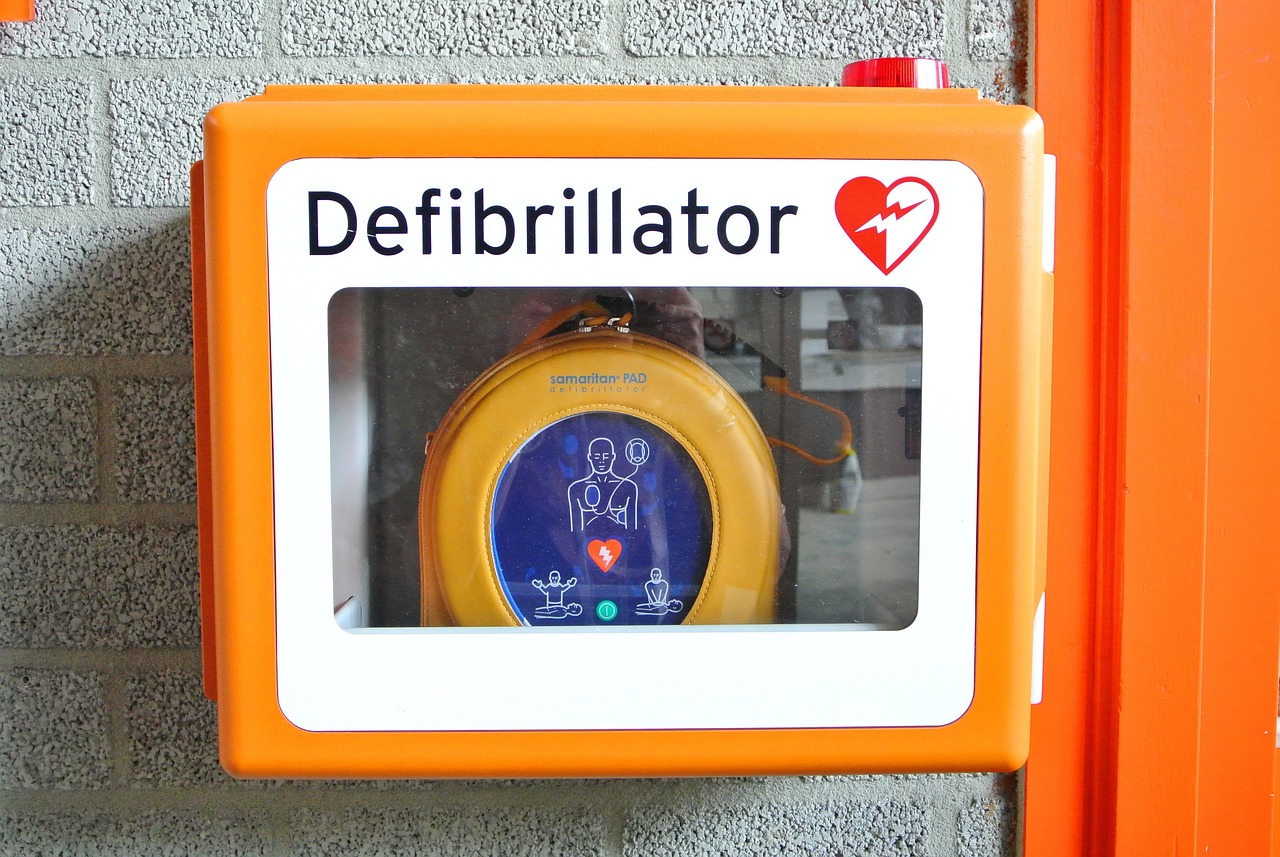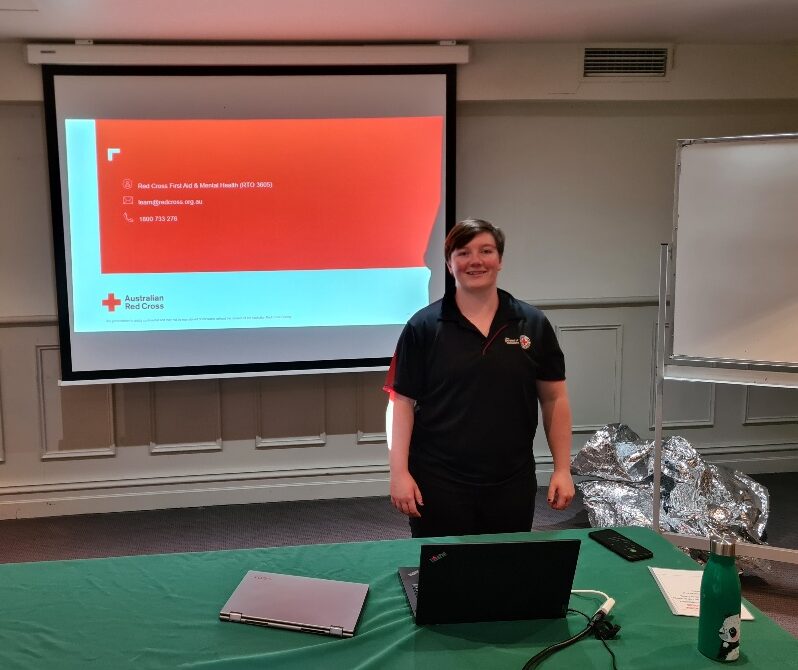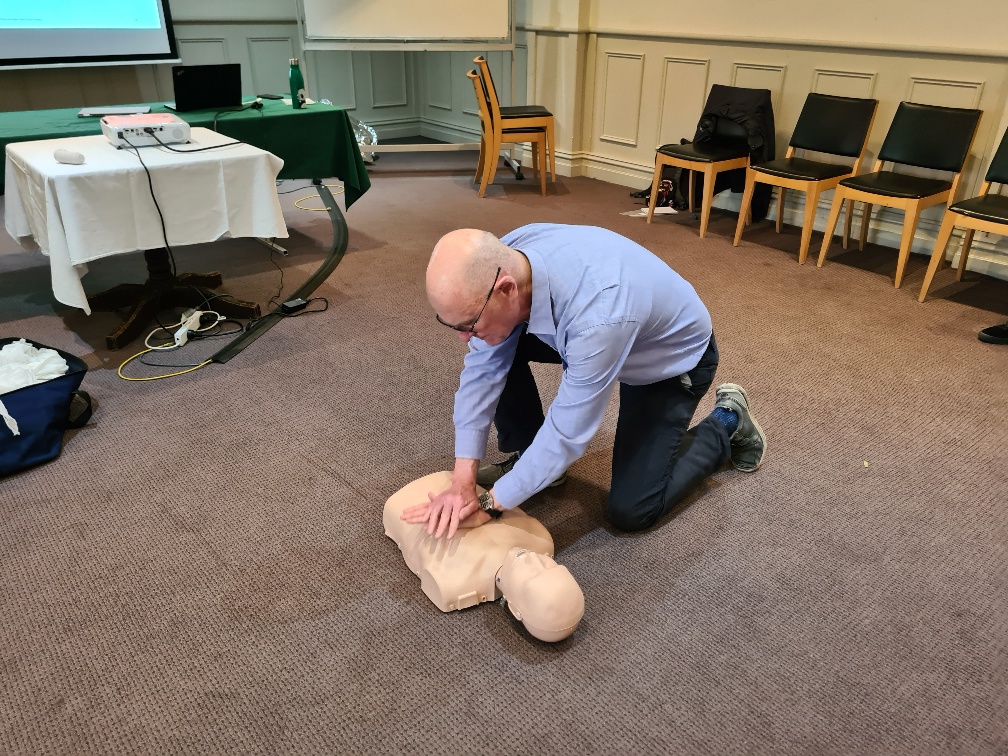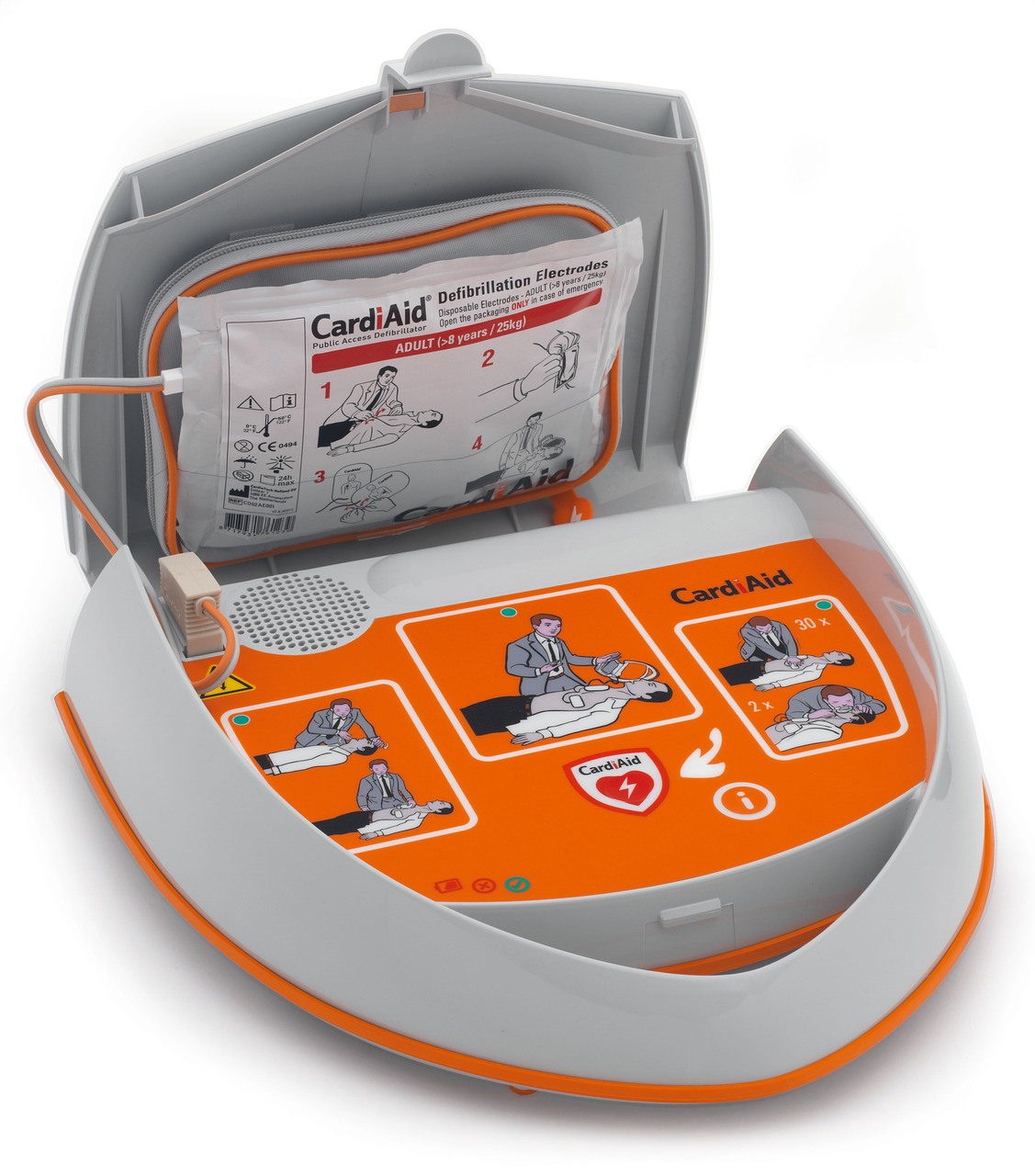Learn English while learning about daily life in Australia, with Rob McCormack
Podcast Number 143 – A First Aid Training Course
(This podcast is 14 minutes and 38 seconds long.)
Hi,
Every year many Australians die prematurely following an accident or sudden illness because they are unable to get the immediate medical help they need to survive. The first few minutes after such an event can be critical. Even though we have an excellent ambulance service here in Australia, it may take around 15 minutes or more for it to arrive, depending on where you live. It is in these first few minutes after the accident or sudden illness that a person skilled in first aid can make a real difference. Sometimes even small actions can make the difference between life and death for a heart attack victim. Recently I decided to take a first aid course so that, should I come across someone who has had an accident or sudden illness, I might be able to help and make a real difference. In this podcast, I would like to tell you about my experience of doing this first aid course and hopefully explain the value of knowing basic first aid. (Please note that this podcast is not designed to give you first aid information. Download the Australian Red Cross First Aid App for first aid information. See https://www.redcross.org.au/firstaid/firstaidapp/).
In Australia, Red Cross runs first aid courses for people in workplaces, sports clubs or just the general public (like me). I have a lot of trust in the Red Cross so I thought I would choose them to do my training. They do wonderful work in helping Australians in times of disaster or special need. https://www.redcross.org.au/. I have great respect for what they do and have donated to them in the past, so they were my first choice for my first aid training course.
The course I chose was a blended course. That means it had both an online component for the theory and a face-to-face classroom component for more practical aspects. That seemed like a good mix for me. It was not that expensive and I think well worth spending the money. After enrolling online, I received my course details via email. This included my login details for the online training component and the time and place for my classroom component.
I thought I would do my online course in the week prior to my classroom training. That way, the information would be fresh in my mind when I did the classroom part. The online course was around 4 hours long and I must admit that it was a lot of information to take in. I think maybe I spent a little more than 4 hours. After each section, there was a short multiple-choice test. You could only proceed with the online course when you had achieved 100% on each test. Luckily, they gave you feedback about each answer, so it was easy to find out why you got one incorrect. By doing the test again, you could correct any error and learn from your mistakes. It’s a good feeling to get that 100% result at the end of each test.
The online course was quite detailed. It covered many topics, including the objectives of first aid. First aid is all about helping the victim before the ambulance arrives with professional medical help. The objective of the first aid person is to preserve life by protecting a person’s airways, stopping any bleeding, preventing further injury, comforting and reassuring the victim, and most critically, sending for help by calling 000. Where a patient is unconscious and not breathing, the course teaches you how to perform CPR (Cardio Pulmonary Resuscitation) and how to use a defibrillator. CPR involves pumping or compressing the chest with your hands as well as giving rescue breaths to the patient – 30 compressions followed by 2 rescue breaths. The defibrillator is a device which provides an electric shock to the chest to get the heart beating correctly. Whilst I had seen and been taught CPR before, I had never learned about defibrillators, so that was new for me.

A defibrillator in place in a building, ready for use if required.
Image by Tanja-Denise Schantz from Pixabay.
As I went through the online course and learned about these techniques, I knew I would get the chance to actually practise using them in the classroom course. I was looking forward to that.
Whilst CPR and defibrillators are used for people who have lost consciousness and who are not breathing (such as in a heart attack), there are many less serious first aid situations where a first aid person can also help. These are well covered in the course. Topics include (amongst others) what to do in cases of asthma, bites and stings (including snake bite), bleeding, burns, choking, electric shock, fractures (or broken bones), hypothermia and hyperthermia, poisoning, seizures, shock, stroke, sprains and strains. Anyone interested in learning about these topics should consider doing a first aid course.
Finally, the day came for me to attend the classroom course. I was as ready as I could be. There were around 20 people there, all of whom (except me) were sent there by their employers so that they could become first aid officers back in the workplace. In Victoria, it is a requirement that every workplace provides certain first aid facilities, including first aid kits and volunteer first aid officers who can assist in the case of a medical emergency. When I was working at Australia Post, I had been one of these first aid officers. However, that was around 20 years ago, so I had forgotten most of what I had learnt back then about first aid.
The teacher was Alex.

My first aid trainer Alex, who delivered the course with enthusiasm. Alex really knows about first aid.
Alex explained to us all about the day’s training. It would be about 6.5 hours, so pretty much all day. I could tell it was going to be an interesting day, as Alex tried to make the course fun as well as informative, which I really appreciated. Alex was very knowledgeable and was obviously a very experienced teacher of first aid.
During the course, Alex covered all of the areas I had studied in the online course, which helped to improve my knowledge. For example, it was great to practise tying a sling and a bandage, and also putting on a special bandage used for a snake bite. The most interesting parts however were the sessions on CPR and use of the defibrillator on an unconscious person who is not breathing. They were very practical and invaluable.
For these sessions, we used a special first aid dummy or manikin.
This is made of special plastic and rubber and looks like the top half of a real person. It allows you to get a feel for what it is like to give CPR and mouth to mouth breaths. For example, when you compress the chest when giving CPR, the manikin lets you feel resistance and measures how fast you are doing each compression. The required rate is 100-120 compressions per minute. You must do 30 compressions followed by 2 rescue breaths. There are lights on the manikin which glow green when you are compressing at the right rate, and to the required depth, which is one third of the height of the chest. It turns out that giving CPR is actually quite tiring. If you had to do it for, say, 10 or 20 minutes before the ambulance arrived, that would be hard work.
If a person is unconscious and not breathing, such as in a heart attack, then the best thing to do is use a defibrillator, which will deliver an electric shock to the heart to bring back a normal heart beat. I was amazed how easy they are to use.
The defibrillator gives you verbal instructions out loud and in a commanding voice, about what to do. It tells you where to attach the wired pads to the patient’s chest, when to stand back from the patient, when to press the button to deliver a shock, and when to keep doing CPR after giving a shock. Our teacher Alex told us that, when a defibrillator is used, around 70% of unconscious people survive which is high. We practised in pairs and I must say this type of learning is really effective. While all this training was quite intense, Alex controlled the session really well, making sure that everyone had a chance to be involved and to learn the skills.
At the end of the day’s training, I felt really satisfied that I had learned new skills which could possibly help save a life someday. I hope I never have to use these skills, but I am glad that I did the course. Becoming a qualified first aid person is something really worth doing.
If you have a question or comment to make, please leave it in the comments box at the bottom of this page. Or, you can send me an email at rob@slowenglish.info. I would love to hear from you. Tell me where you live, a little bit about yourself and what you think of my Slow English podcast. I will write back to you, in English of course. If you would like to take a short quiz to see if you have understood this podcast, you will also find it on my website. Goodbye until next time.
Rob
Podcast 143 Quiz - Did you understand the podcast?
You can take the quiz as many times as you like.
Vocabulary
accident = when something goes wrong, like a car crash or a fall
actions = things that you do
ambulance = a van which takes sick or injured people to hospital
appreciated = feeling thankful
asthma = a problem in the lungs where you cannot breath properly
bandage = a piece of cloth wrapped around a wound or injured body part
basic = the minimum things which are needed
choking = when something is stuck in your throat and you cannot breath
commanding voice = (here) a loud voice which makes you listen
component = part
compress = to press down
compression = the act of pressing down
consciousness = being aware of what is happening around you
critical = very, very important
designed = made a certain way, made for a special purpose
detailed = when there is lots of information
disaster = a fire, a flood or an accident that causes harm to people
donated = to give money or things for a good cause (e.g. those who are poor)
electric shock = when an electric current (electricity) passes through your body
employers = the bosses, who give you a job
enrolling = to sign up to do a course
error = a mistake, when something is wrong
experienced = when you have done something before many times
facilities = places or equipment which make it easier to do something
first aid officers = people in the workplace who are trained in first aid
forgotten = have not remembered
heart attack = when your heart can’t get pump normally
hyperthermia = when the body gets too hot
hypothermia = when the body gets too cold
informative = when you receive lots of useful information
intense = (here) strongly, requiring a lot of concentration
invaluable = worth a lot, very valuable
involved = to be part of something or part of a process
kits = a collection of things (usually in a box or bag) for a particular purpose (e.g. a first aid kit)
knowledgeable = to have lots of knowledge about a topic
measures = to find out how much there is of…weight, force, height, length etc
medical = to do with your body and your health
mistakes = an error, when something is wrong
multiple-choice test = a test where you select the answer from a list of possible answers
poisoning = when someone eats or drinks a poison which can make them sick or die
practical aspects = involved with doing things (usually with your hands)
practise = to do something many times in order to learn it
prematurely = before the due time, ahead of time, early
prior = before
proceed = to go forward, to continue
professional = when trained people are paid money to do something as a job
public = all the people in the community
qualified = (here) when you have been trained and have shown you have the skills
requirement = the need, a rule
rescue breaths = to give mouth to mouth resuscitation to another person
resistance = (here) when something is hard to move
respect = when you believe that someone is very good and can do a good job
section = part
seizures = when the brain suddenly stops work correctly and the person falls to the floor
situations = how things are at a particular time
sling = a piece of cloth which is used to support your arm when it is injured
sprains = when you hurt one of your joints (e.g. ankle)
strains = when you hurt one of your muscles
stroke = a blood clot in the brain which can injure or kill someone
sudden illness = when you get sick very quickly, such as a heart attack
survive = to stay alive after a dangerous event
techniques = ways of doing something
theory = (here) ideas and knowledge about a topic
tiring = when an activity makes you tired
trust = when you believe someone is reliable, truthful, knows a lot
value = how much something is worth
verbal instructions = instructions given out loud
victim = a person who is injured or killed because of an accident or event
volunteer = someone who does a job without being paid
wired pads = (here) pads with a wire attached which go back to the defibrillator



June 18, 2024 at 12:42 am
Hi Rob, thank you so much for sharing this podcast! I’ve learnt a lot from this! btw, I wanna mention a small grammar mistake in the transcript, which is “Anyone interesting in learning about these topics should consider doing a first aid course.”, I thought maybe the correct one is “Anyone interested in …” , right? Again, I really appreciate your work of sharing the first aid class. Have a nice week!
June 18, 2024 at 7:39 am
Hi Qianhui,
Many thanks for your comment. Yes, that is an error in my podcast, which I have now corrected. Many thanks for letting me know.
Have fun learning English.
Have a great day.
Rob
November 29, 2022 at 7:58 pm
as always, your podcasts are beneficial, clear, not fast, easy to learn, understandable and informative.
thank you so much.
I wish you can do a podcast about the healthcare system in Australia and medicare card types.
November 29, 2022 at 10:00 pm
Hi Akram,
Many thanks for your comment and your kind words about my podcast. I have done a podcast about Australia’s health care system. It is podcast number 13. https://slowenglish.info/podcast-13-health-care-in-australia/
Have a great day.
Regards,
Rob
November 18, 2022 at 10:49 am
What a great summary of the process for booking and completing the Red Cross course…and the value and importance of knowing First Aid to help save lives.
Beneficial for you, your family, your friends and the community. Inspiring post.
November 18, 2022 at 4:34 pm
Hi Wendy. Many thanks for your comment. Yes, a worthwhile course indeed. Your comment says it all. Cheers. Rob.